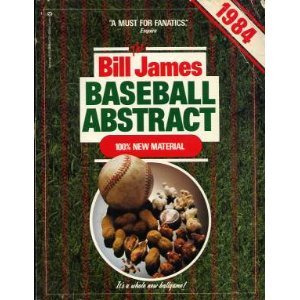On geeking out
I’ve always been the sort of baseball fan who appreciates the tactile aspects of the game—the way the grass smells when winter breaks and spring training reports hit the local news, the endless patterns pine tar makes on a batter’s helmet, the unmistakable sound of a home run.
But the more scientific parts of the game‐the part that encompasses strategy, the “double switch,” choosing a lineup—that part has always been more work for me. I suppose it’s because I’ve always been a player of the sport first, and a student of it second, which I know seems somehow counterintuitive and counterproductive, but there you have it.
Having not picked up a book on baseball in recent memory, I of course had no idea where to start. Luckily enough, it turns out I didn’t have to puzzle over it for long.
My husband came home a few weeks ago after a late night of work and handed me a book. Well, something like a book, but with pages that reminded me more of a cross between newsprint and construction paper than the norm.
 Point of fact: my husband is pretty amazing. Not only does he support and encourage my obsession with becoming a third baseman, he is so aware of my abiding love for baseball that when he is leaving his office on the campus of Michigan State University, he will stop when he catches a glimpse of the word “baseball” and the year “1984” and snatch the book, The Bill James Baseball Abstract 1984, which was left on a table of similar misfit publications for students, faculty, et al to adopt.
Point of fact: my husband is pretty amazing. Not only does he support and encourage my obsession with becoming a third baseman, he is so aware of my abiding love for baseball that when he is leaving his office on the campus of Michigan State University, he will stop when he catches a glimpse of the word “baseball” and the year “1984” and snatch the book, The Bill James Baseball Abstract 1984, which was left on a table of similar misfit publications for students, faculty, et al to adopt.
In case you’re wondering, The Book didn’t make the glowing, divine sound associated with such revelations—not until I tweeted about it and the sage Tim Carmody (whose scientific understanding of baseball has served as the number one fuel for my desire to become a brainier baseball fan over the past few years) replied that he had “geeked out” over two editions in his youth.
Now slow down, dear reader, we aren’t going to get to the meat of The Book yet. But I do want to suggest that we (you, I, and my mother, who graciously reads everything I write) adopt Bill James’ guiding framework for considering baseball.
He writes first about inside baseball, and how little it does to actually illuminate the game for us, the fans, because we are not the insiders—in fact, the only insiders are the players themselves, and even back in 1984, the growing divide being fan and fanatic was troubling.
Players used to have public nicknames, wild things like Circus Solly and affectionate names like Sunny Jim and Unser Choe (Our Joe) and media handles like the Commerce Comet and the Donora Greyhound. Now the big thing is to have private nicknames. The players invent them and use them and then the reporters make a game out of trying to overhear them and find out and find out where they come from and reveal them to the public; once revealed they evaporate, for their only purpose is to designate in code the speaker and the one spoken to as true insiders.
Let’s agree now that “Rounding Third” will not attempt to deal with insider baseball. Let’s agree that the closest I, a 30-year-old woman learning to play third base, can come to understanding the experience of an elite athlete, is by training to become a much better athlete—and let’s leave all that to the “Project 3B” writing.
What will we do here, then? Again, James gets it right.
This is outside baseball. This is a book about what baseball looks like if you step back from it and study it intensely and minutely, but from a distance.
What can we expect to tackle, then, these few months before position players report to spring training?
Much as I have been learning how wrong the conventional axioms of playing baseball are (“keep your back elbow up,” etc), so too are the conventional axioms about what makes a winning team work, and a losing team collapse.
Gear up, kids. It turns out clutch hitting is a myth, it’s not just a matter of a few breaks not going your team’s way, and you really aren’t that close to making the playoffs.
I hope you are as (nerdily) excited about this as I am.
Like.
(My dad feels that the “elbow up” is getting a bad rap, that it’s still important as one part of the complete swing ; )
My coach would say that it’s a small element of the kinetic chain that defines a good swing, and that having the back elbow “up” isn’t the ideal position unless you’re a super strong hitter with superior bat speed (Ken Griffey Jr., Miguel Cabrera, etc.). What’s really amazing to me is how many different elements of the swing there are, and how they sort of domino into one another.
Interesting, sounds like a different analogy on the sport we love. I will have to look into that.